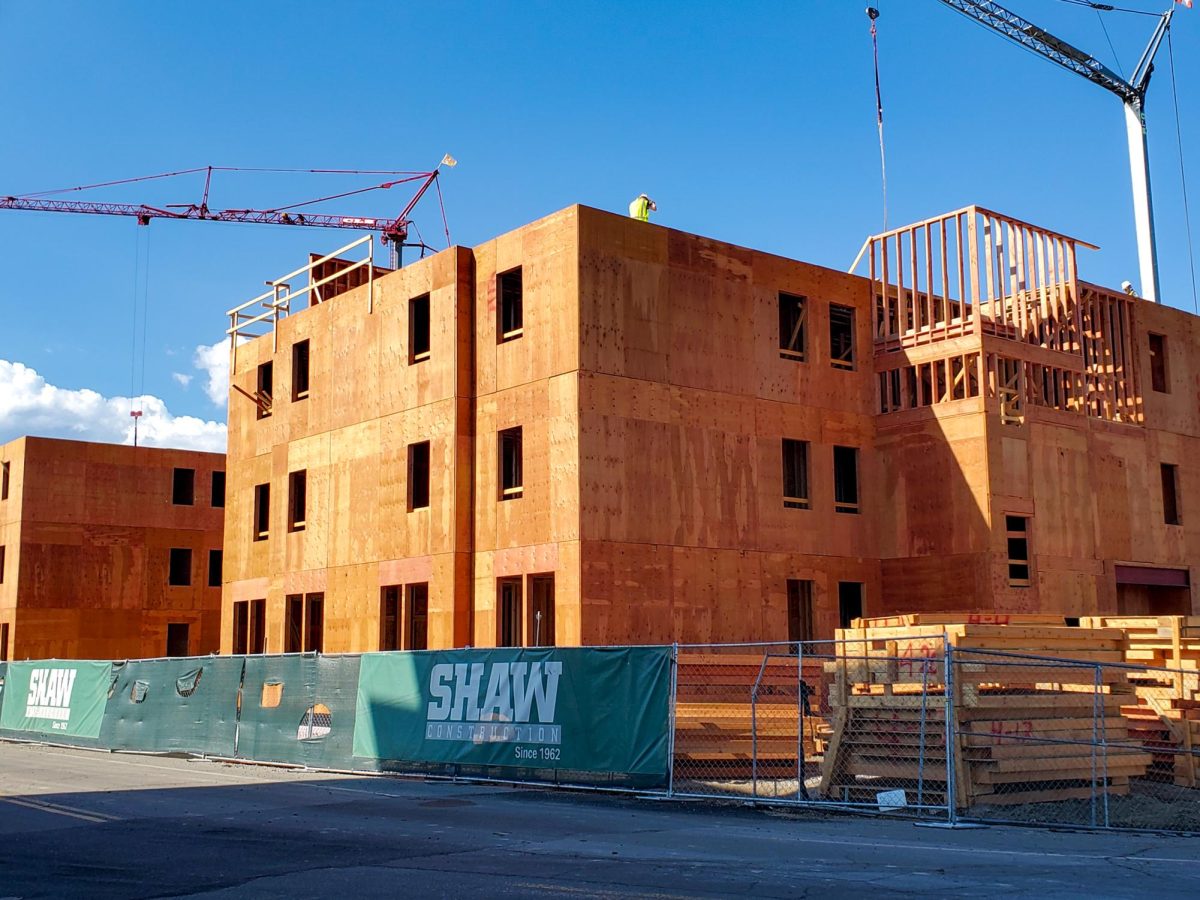
Teagan Meens
Shaw Construction began work on the Centennial Village Apartments during the summer. This on-going housing project is a part of the university’s new Formation District.
A bold start to the next century is CMU’s message as its 100th anniversary begins. The CMU Century Project is celebrating 100 years of the university’s history with year-round events and $100 million of campus-wide construction.
Despite these new construction projects, the current availability of food, housing and parking at CMU has transformed the campus experience. Since the housing demand exceeded capacity in fall 2024, many students began their school year within the Bridge Housing program and lived in hotels off campus.
Following increased demand from students who are interested in living on campus, Residence Life sent an email in January 2025 that informed students who had lived on campus for at least two years that they would not have access to the housing application for the upcoming school year in August.
As a solution, the university ordered the construction of new housing and food options for students, in the form of The Formation District in winter 2024. This new section of campus is between the Asteria Theatre and Bunting Hall. Its offerings include the construction of the Formation District Dining Hall and the Centennial Apartments. Both facilities will open in fall 2026.
Frequent CMU collaborator, Shaw Construction, is the main force behind The Centennial Apartments’ construction, with its name honoring CMU’s 100th anniversary. This new five-story residence hall will offer students apartment-style housing with 83 rooms and 310 beds.
“It’s a game-changer for CMU’s housing options!” said director of Residence Life Emily Bollinger.
Outside of housing concerns, the influx of new students on campus meant CMU’s main dining hall, The Caf, officially exceeded its back-of-house capacity. Leadership also conducted an internal study and officially determined that its current food services cannot adequately meet the needs of all students. As a result, students often encounter long lines and food shortages.
“This has caused me to choose the shortest line, rather than the food I’d normally want on several occasions and has caused me to eat less than I usually would,” said freshman mechanical engineering student Alistair Clark.
The construction of the Formation District Dining Hall intends to address back-of-house capacity shortages, existing food service issues and an increased demand for meal plans. Haselden Construction is overseeing the project and it will sit north of the Centennial Apartments.
According to a BidNet Direct construction request from CMU, this 20,000 to 25,000-square-foot facility will provide a blend of retail and cafeteria dining. Unlike The Caf and other facilities on campus, this food hall will be explicitly open to CMU students and the public. Additionally, it will offer both indoor and outdoor seating options.
The designers of both buildings blended the styles of the other Formation District facilities, like the Asteria Theatre and Hotel Maverick, with other buildings in the area, like the Lucero and Bunting residence halls.
The CMU Century Project also includes other construction efforts. Nestled between the Wubben and Horace Science Hall and Tomlinson Library lies a winding walkway surrounded by benches with overhead lighting and shade structures. The recently completed Formation District Art Walk is the campus’s newest outdoor space for studying and reflection.
“The art walk is a place for students and the campus community to relax and enjoy. It’s another beautiful pocket of life we’ve worked to create on campus,” said executive assistant to the vice president of communications Haley Hahn.
Right across from the Formation District Art Walk is the Moss Performing Arts Center, which is currently receiving interior renovations. Construction will continue through the current school year and finish in fall 2026.
According to another BidNet Direct construction request from CMU, the Moss Performing Arts Center’s renovations will “address safety, accessibility, and code compliancy,” as well as “increase capacity to accommodate additional students, staff, and community members.”
Through its fifth project, a new parking lot, CMU hopes to address complaints about the lack of parking on campus and expand its infrastructure. A recycled asphalt parking lot where the Albertson’s once stood will provide 217 new parking spots.
The university also demolished several houses near Confluence Hall to expand and pave over the existing parking lot. A portion of this parking lot should be available for student usage by the end of the fall semester.
The Davis House, situated on Seventh Street next to Confluence Hall, is the sixth project associated with the CMU Century Project. With its vibrant new paint job and landscaping overhaul, the Davis House will serve as a key gathering spot for many members of the CMU community in the future.
The space takes its name after CMU Trustee Ron Davis, who is a major contributor to CMU Foundation scholarships and on-campus initiatives. It will serve as a meeting place for student populations, like the Guardian Scholars. However, it will be open to the broader campus community for smaller occasions.
CMU is also prioritizing the Grand Junction community by partnering with local businesses for all six projects. Headquartered in Grand Junction, Shaw and Haselden Construction serve as primary contractors, alongside many local subcontractors.
As CMU enters its second century, its leaders are emphasizing community involvement and growth through new construction efforts. For the university, these projects are just the beginning.